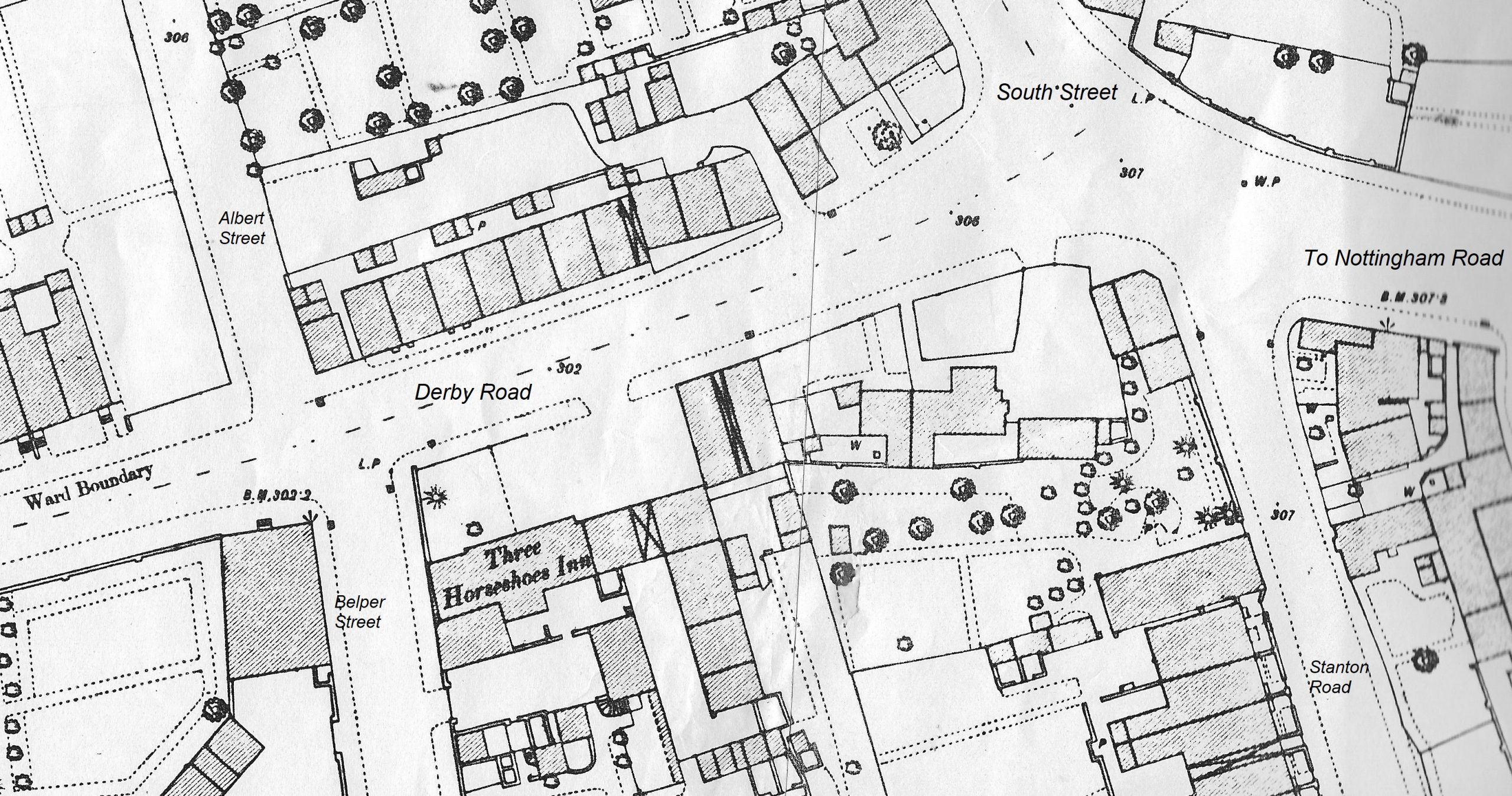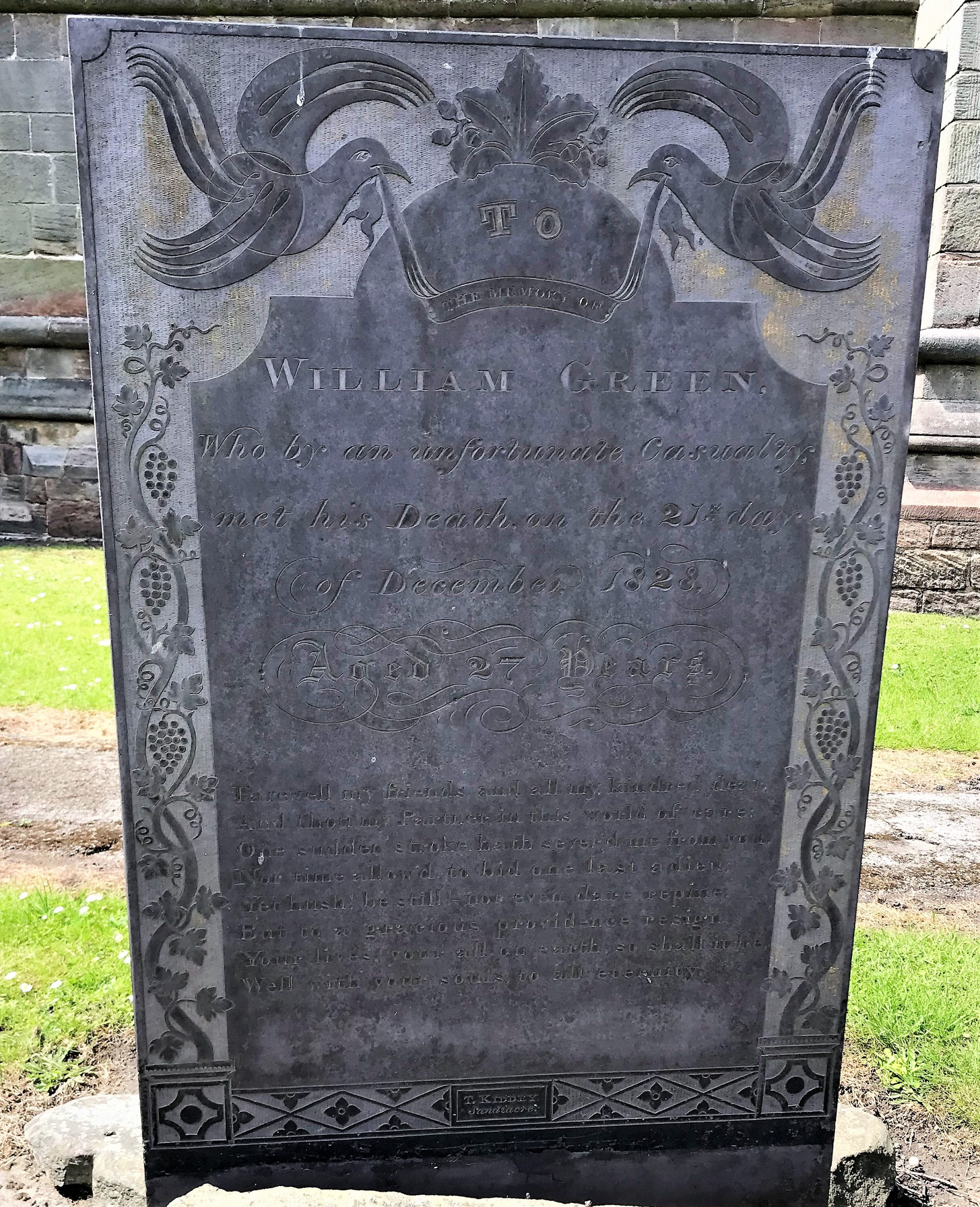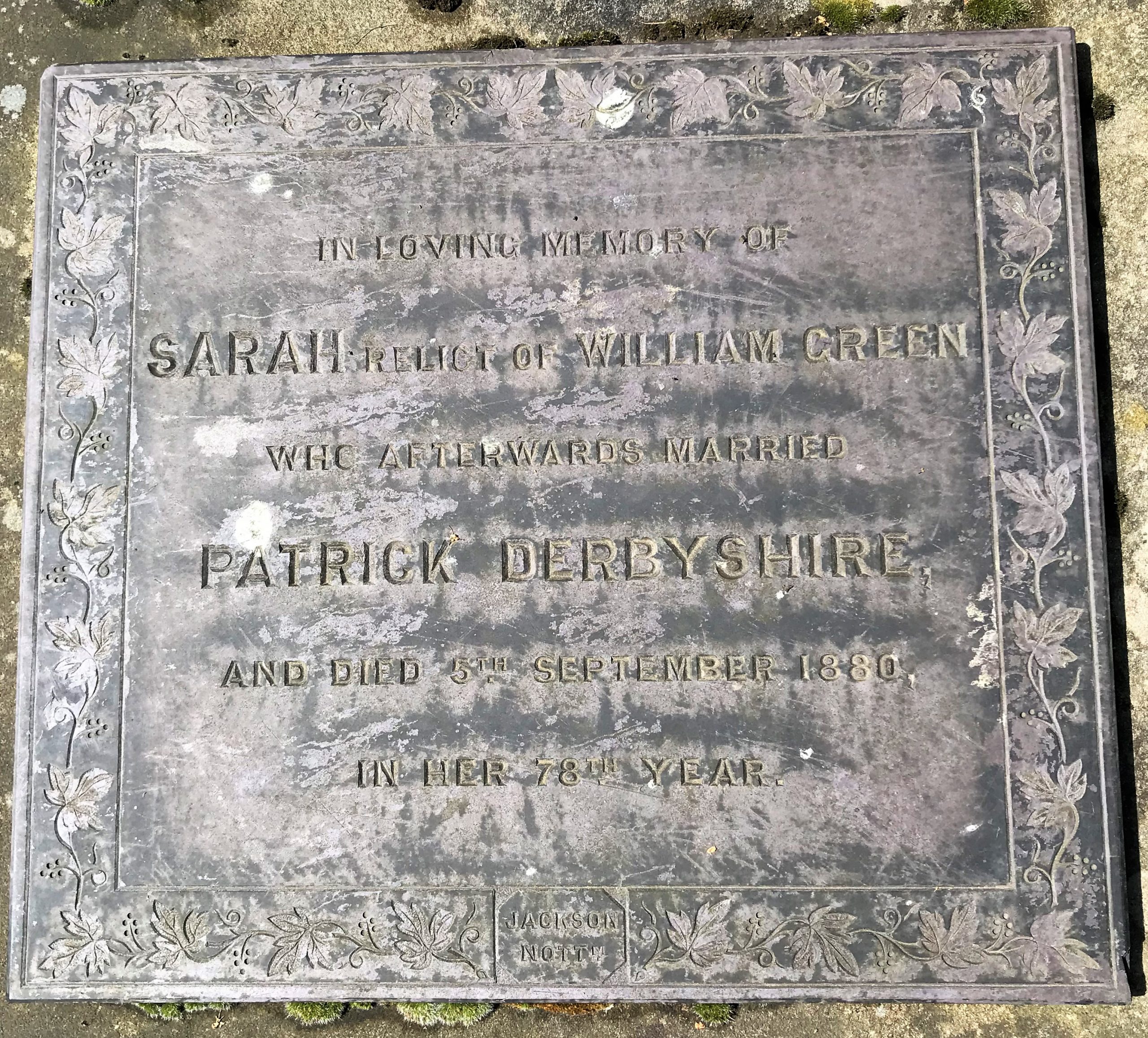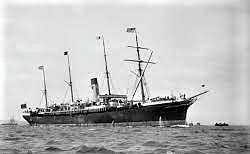Stanton Road was where Job Derbyshire and his family lived.
Adeline points out that “Stanton Road had three shops in it.”
Looking closely at the map above you should be able to determine the three shops at the corner of Derby Road and Stanton Road. There was no land attached to them and “the first faced the Toll Gate. It was built in the garden of the old Farm House. Job Derbyshire used it for a butcher’s shop.” The buildings themselves were anything but attractive.
Immediately behind them, on the west side of Stanton Road, “was a garden bounded by a wall to the lane, and then came an attractive dwelling of the modern farm-house type. This was rather picturesque and belonged perhaps to the early 18th century … it had, I think, a thatched roof.”
“Job Derbyshire and his family lived in this old Farm House”. (Adeline)
Much of this is recalled by ‘Tilkestune’ of the Advertiser (IA March 1929) who also remembers that the house faced south, though it also had a door and a window or two on the north side. Adeline disagrees, stating that “Job Derbyshire’s farm house was on the right side facing north, with gable up to the road.”
In 1871 this was 18 Stanton Road.
————————————————————————————————————————————————–
Patrick and Sarah Derbyshire
Born in 1803 Sarah Simpson was the oldest surviving child of Boot Lane (Stanton Road) farmer and boatman John and Sarah (nee Nightingale) when she married boatman William Green on October 19th 1824. A little over four years later William Green lay buried in St. Mary’s churchyard and Sarah was a widow.
His stone can be found in the main graveyard, east of the chancel.
To the memory of William Green
Who by an unfortunate casualty,
met his Death on the 27th day of December 1828,
Aged 27 Years.
Farewell my friends, and all my kindred dear
And thou my Partner in this world of care
One sudden stroke hath severd me from you
Nor time allowd to bid one last adieu
Yet hush ! be still ! nor even dare repine
But to a gracious providence resign
Your lives, your all on earth, so shall it be
Well with your souls to all eternity.
But what was the ‘unfortunate casualty’ which severed William from his partner Sarah ?
Just before Christmas Day in 1828 William was master of a boat moored at the Swan and Salmon boat yard at Newark on Trent, about to journey north to Gainsborough, when a swaying spar knocked him into the water. He immediately sank and his body was recovered only some time later, to be returned to Ilkeston where he was buried in St. Mary’s Churchyard.
Three years later, on New Year’s Day 1832, Sarah married West Hallam farmer Patrick Derbyshire and spent some time at that village where son Job Nightingale Simpson Derbyshire was born in 1833. He was the couple’s second but only surviving child. (Their daughter Maria died, aged 8 months, in November 1832)
By 1851 the family had moved into Boot Lane, later known as Stanton Road, close to the home of Sarah’s parents.
On a late August Sunday evening in 1863 and feeling unwell, Patrick had to leave the service at St. Mary’s Church early. He walked down Anchor Row to Dalby House, to consult Dr. Norman who gave him some medicine. The farmer confided to the doctor that ‘it is all over with me’ and he was right. He immediately expired. His body was eventually taken home in a cart through streets reportedly crowded with people keen to get one more view of their neighbour.
Patrick was aged 68 and was buried in the extension graveyard at the parish church.
His widow Sarah died at 17 Stanton Road, the home of her widowed sister Mary Lowe, on September 5th, 1880 aged 77.
Sarah’s plaque in St. Mary’s main churchyard, east of the chancel
——————————————————————————————————————————
Their only son, Job Nightingale Simpson Derbyshire (1833-1886)
Their son Job — born in West Hallam in October, 1833 — married Mary Marshall White, eldest daughter of Cossall farmer Joseph and Eliza (nee Marshall), on March 14th, 1859.
A bluff, outspoken butcher and a staunch Conservative, Job featured in the following limerick ….
There was a butcher named Job,
Who always wore a blue robe,
He would vote for a post,
If ‘twas blue, and his boast
Was that none was so sharp on the globe.
(At this time the colour blue was associated with Tory allegiance, as it is today, while yellow was the badge of the Liberals)
In 1865 there was a serious outbreak of cattle plague (rinderpest) in England which continued into 1866. Certain conditions on the keeping and movement of livestock were imposed, in an effort to contain the disease … obviously this was not the best time to purchase or move cattle around the country. But this is precisely what Job decided to do.
In mid-June of 1866, accompanied by Samuel Revill, veterinary surgeon of Bath Street — was he there to provide expert advice ? — Job drove to Heanor where he purchased a few calves. Now he had to obtain a removal order so he could drive them back home, and this meant visiting the home of Superintendent Shaw to gather the necessary paperwork.
Arriving there, he got down from his carriage, walked down a side passage to approach the house and was almost immediately faced by a screaming woman, rushing towards him. This was ‘Mrs. Shaw’ and she was screaming because the back of her dress was on fire.
Aided by a neighbour, a passer-by and his own presence of mind, Job was able to extinguish the flames and return the woman to the security of her home. Though badly burned on her arm, neck and back, her life was not threatened. The local press speculated that she would surely have ‘burnt to death‘ but for the prompt actions of Job and the neighbour — the other women who were close to Mrs. Shaw were ‘paralysed’ with fear and so ‘unable to do little, if anything, in the way of assistance‘.
‘The heroism‘ displayed by Job and his ‘mate’ was ‘beyond all praise. Their combined efforts saved a fellow creature from a fearful death, and they cannot but feel grateful that they were privileged to do so, and also feel that praise in the circumstances is not worth having’. (IP)
It later emerged that Mrs. Shaw had been washing clothes in the outhouse and had stood too close to the fire heating her water.
—————————————————————————————————————————–
The children of Job and Mary Derbyshire
Adeline remembers (though not completely correctly) that “there were five children, Sam, Simpson, White, Kate and another girl.”
Samuel Patrick (1860-1931)
This oldest child was originally named Sam White Derbyshire but a month later and at his baptism his name had changed to Samuel Patrick.
Attending Trent College in 1875 Samuel Patrick was awarded a Third Class in the Cambridge University Local Examinations which had been established in 1858. For the first seven years of their existence these exams were only open to boys but then girls were permitted to enter and compete on the same terms as boys — although their names were not published in the local press, unlike the boys’ names.
In 1893 Samuel Patrick married Lucy Cockett, daughter of farmer and fruit grower John and Susannah (nee Patrick) of Walsoken, Norfolk.
The couple spent the last decades of the Victorian era in Nottingham, where Samuel had moved in 1875, and where he practised as a chartered accountant. However this didn’t stop him travelling extensively — visiting Constantinople, Moscow, St. Petersburg, and throughout America as far west as Colorado. But always coming back to Nottingham “whose sanitary arrangements, capital water supply, pure air and general residential attractiveness and well being” could not be surpassed.
In religion Samuel Patrick was a Baptist and a member of the Nottingham Tabernacle, being one of the founders of its famous Tabernacle Temperance Choir in 1884, and also of the Band of Hope attached to the Church. Although a firm believer in the teaching of temperance principles to young children, he was firmly against any system of compulsion.
 Samuel Patrick Derbyshire (from the Nottingham Daily Express, October 31st 1898)
Samuel Patrick Derbyshire (from the Nottingham Daily Express, October 31st 1898)
In 1888 he was elected as borough auditor, as a Liberal, but because of ‘business pressures’, resigned that post after only two years. Then for several years he was the auditor for the Nottingham and District Tramways Company and had a keen interest in ‘street transportation’. His travels in the States showed him how far ahead that country was in the matter of tramways — stemming mainly from the way that the roads in the townships and cities were organised; all streets radiating from the central square in straight lines. He was also auditor for the Notts County Cricket Club
In November 1898 he stood for election as a Liberal candidate at the municipal elections, in the Meadows Ward of Nottingham City but sadly for S.P. he lost — 810 to 656 votes.
John Simpson (1861-1939)
As a youth John attended the Church Mutual Improvement Society where in March 1879 he opened a discussion on fox hunting, his view being that it was ‘cruel, unjustifiable and a disgrace to a Christian country’. An opposing view was put forward, that every sport – hunting, fishing or shooting – involves some pain, and that the abolition of fox hunting ‘would alter the whole physical condition of the English race’. This was the view which prevailed at the meeting when put to a vote.
J.S. married governess and music teacher Margaret Wright, youngest child of Radford lace manufacturer James and Sarah (nee Burton?) on April 29th, 1886 and continued to live in Nottingham. He traded there as grocer, tea merchant and confectioner, “whose toffee had far more than a local reputation”. (Old Resident)
William Joseph White (1863-1880)
While living at Stanton Road, William Joseph White Derbyshire died of consumption one quiet Sunday evening, October 3rd 1880, a young man of 17, and his gravestone can be found in the extension to the churchyard of St. Mary‘s, the church where for nine years he was a member of the choir.
Hushed is the voice that here joined in our praises,
Sleeping the form that trod the broad aisle;
Now with the angels his anthem he raises,
Pure as the crystal, untainted with guile’.
Sheddie Kyme recalled him as “one of the brightest and best scholars at the National School. No boy at the school was held in higher esteem by his fellow scholars” and the writer remembered with pleasure “many of his vocal efforts while in the choir of St. Mary’s. His treble voice was one of the best, and he experienced no difficulty in reaching his top notes, which were always clear and faultless in tone. A slight impediment made his singing, if anything, more effective from the standpoint of simplicity”.
At White’s funeral the following Wednesday afternoon, the church choir of nearly 30, attired in surplices and wearing black rosettes, marched in procession from the Stanton Road home to the Parish Church where a choral service was then opened.
One of his favourite hymns was the funeral song …
Days and moments quickly flying
Blend the living with the dead;
Soon our bodies will be lying
Each within its narrow bed.
(Words by Edward Caswell 1858, music by John B. Dykes, 1862)
“This was sung in church on the occasion of the internment of his remains, and if a tremor was perceptible in the voices of the choristers entrusted with the portion of the hymn sung as a duet – a duet in which the deceased had taken part on several similar occasions – it was, under the circumstances, excusable”.
At the end of the service the Rev. J. Greenfield, curate-in-charge, gave his address:
“Our departed brother, whose remains now lie before us, was a worker in the Church. You knew him as a member of the choir: he was also a teacher in the Sunday School. He made no claim to any unusual saintliness, but appeared to be just what he was – a fair, average specimen of a God fearing lad of seventeen; one who loved the service of God and honoured his parents; a devoted son of the Church, ever ready to do what he could. The time has gone by when such a spirit and such a practice can be passed by as if of no importance; the Church delights to honour such devotion.
“We mourn the loss of all this promise; but we do not mourn as if we had no hope. The poet tells us that “a flower when offered in the bud is no mean sacrifice”. Our brother has passed away as a flower which developed no further than the bud; but his quiet, cool preparation for death for months past showed how his spirit looked forward to the coming change; and his simple, unostentatious trust and rest in the Saviour allowed that his intelligent faith had laid hold on external life.
“I administered the Holy Rite to him at noon on Sunday, and I saw that although the hand of death was upon him, yet his intelligence helped his faith to realize the Divine presence and support; and at six o’clock he passed away in peace. He fell asleep in Jesus. He has left us; but we have his simple, unostentatious example of readiness always to do what he could, and his trust in the Lord Jesus Christ, as our inheritance; and, being dead, he yet speaks to us”.
Sarah Eliza (1865-1945?)
She married Codnor-born bank clerk Thomas William Taylor at Nottingham on April 24th 1890 and after the birth of their first child Winifred Mary in 1891, they moved to High Street in Alfreton. There Thomas William was branch bank manager at the Nottingham Joint Stock Bank Ltd., later the London City and Midland Bank Ltd. He was also treasurer of the South Wingfield Parish Council, agent for the Scottish Union and National, the Scottish Accident, and the Commercial Union Insurance Companies.
Job Nightingale (1866-1954)
Like his oldest brother, Job Nightingale trained as a chartered accountant and the 1901 census finds him unmarried, boarding at the lodging house of Agnes Elizabeth Travell (nee Woodward), the wife of Nottingham solicitor George Travell Travell (sic), at Derby Terrace, Derby Road in Nottingham. Also at the house was a daughter Agnes Dora Travell who married Job Nightingale four years later. The couple then lived close to brother Samuel Patrick and his family in Magdala Road in Nottingham.
George Henry (1868-1891)
George died of consumption on March 30th, 1891 at Epsom, Auckland in New Zealand … seven days after his arrival. He had departed for Wellington on January 20th of that year on board the S.S. Coptic (below). He was buried the day following his death, at Purewa Cemetery, Meadowbank, Auckland when his age was recorded as 21 although he was 23.
Annie Mary (1870-1954)
Born in 1868 in Hilgay, Norfolk, electrical engineer Gerald Hart Jackson married Annie Mary at Alfreton in 1899. The couple subsequently lived at Northampton where Gerald was manager of an electricity supply company.
Annie Mary died on March 29th 1954 at Great Billing.
—————————————————————————————————————————————————–
The Derbyshire family was still living in Stanton Road in September 1878 when bricklayer Robert Page and an assistant arrived at their house. The pair had been sent by their boss William Warner to erect a chimney pot there, and quickly placed ladders up to and along the roof.
No concerns over ‘health and safety’, and with chimney pot over his shoulder, Robert climbed up to the roof with no problem. But when traversing the roof towards the stack, a stave in the ladder broke and he fell to the ground.
On the way down his fall was interrupted by the other labourer who was on his way up, but soon found himself on his way down too.
Not having so far to fall, the helper was relatively uninjured. Robert however fell upon the chimney pot – which had accompanied him on his journey down – and suffered shoulder and head wounds.
Dr. Samuel Armstrong of Dalby House attended Robert at home and stitched him up.
In the following year Job mortaged his Stanton Road property for £835. It was described as ‘a messuage or tenement, with the cowhouse, barn, outbuildings and appurtenances, and a close of land or homestead thereto adjoining … ‘ In total it covered about 2¼ acres.
—————————————————————————————————————————————————–
“Later on this family removed to Nottingham” recalls Adeline.
Shortly after the death of White Derbyshire — in January 1881 — father Job auctioned off many of his surplus goods in readiness for his departure from Ilkeston. On offer were a light cart and harness, five tons of excellent quality hay, brewing utensils and furniture – bedsteads and mattresses, tables, chairs, fenders, fire-irons, and crockery.
There were also many ‘sundries’ – a good wheel chopper (new!) to cut two lengths, a capital wheelbarrow, lots of old iron, an excellent churn (nearly new!), a cheese pan, butter bowl, four trenchers (a type of wooden or metal plate), tin milk pancheons, milk tins, and other dairy and household requisites.
There were also a couple of cows for sale – one blue roan, four years old, to calve April 11th, and one three years old, to calve April 8th.
With most of the rest of his family Job then moved to Nottingham where he can be found on the 1881 census.
Job Nightingale Simpson Derbyshire died on August 17th 1886 at Cleethorpes, aged 52.
His family home was then at 22 Chaucer Street, Nottingham where he was living with children Samuel Patrick, Job Nightingale and Annie Mary.
We shall examine more closely what happened to Job’s Ilkeston land after his departure from the town in the next section.
—————————————————————————————————————————————————–
The curious case of Sarah Simpson
As you can read at the top of this page, Sarah Simpson was the oldest surviving daughter of Boot Lane (later Stanton Road) farmer John and Sarah (nee Nightingale), and married boatman William Green in October 1824.
Now William Green was the oldest child of farmer George Green of Sough Closes in Ilkeston, and his wife Sarah whom he married in September 1800. Sarah was born Sarah Simpson in 1775, the oldest child of Ilkeston nailor Willoughby and Sarah (nee Greensmith).
Sarah was a widow when she married George … her first husband was Thomas Rimmington whom she married in October 1796. They had one child, Joseph Rimmington, before Thomas died in 1798.
Now in December 1835 Joseph Rimmington married Sarah Simpson the youngest daughter of Ilkeston boatman Joseph and Sarah (nee Hawley) … Joseph being the oldest son of Willoughby and Sarah (nee Greensmith).
Thus the second Sarah Simpson was the mother-in-law of the first one and the aunt of the third one.
—————————————————————————————————————————————————–
Let’s now continue the story of the Derbyshire Estate





